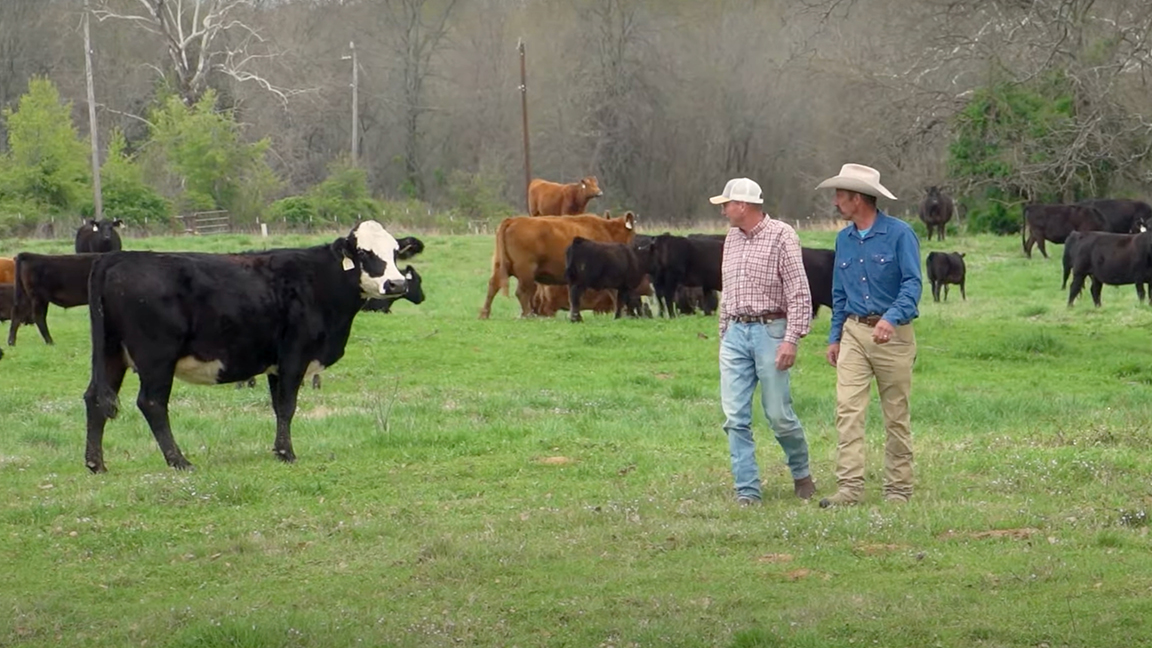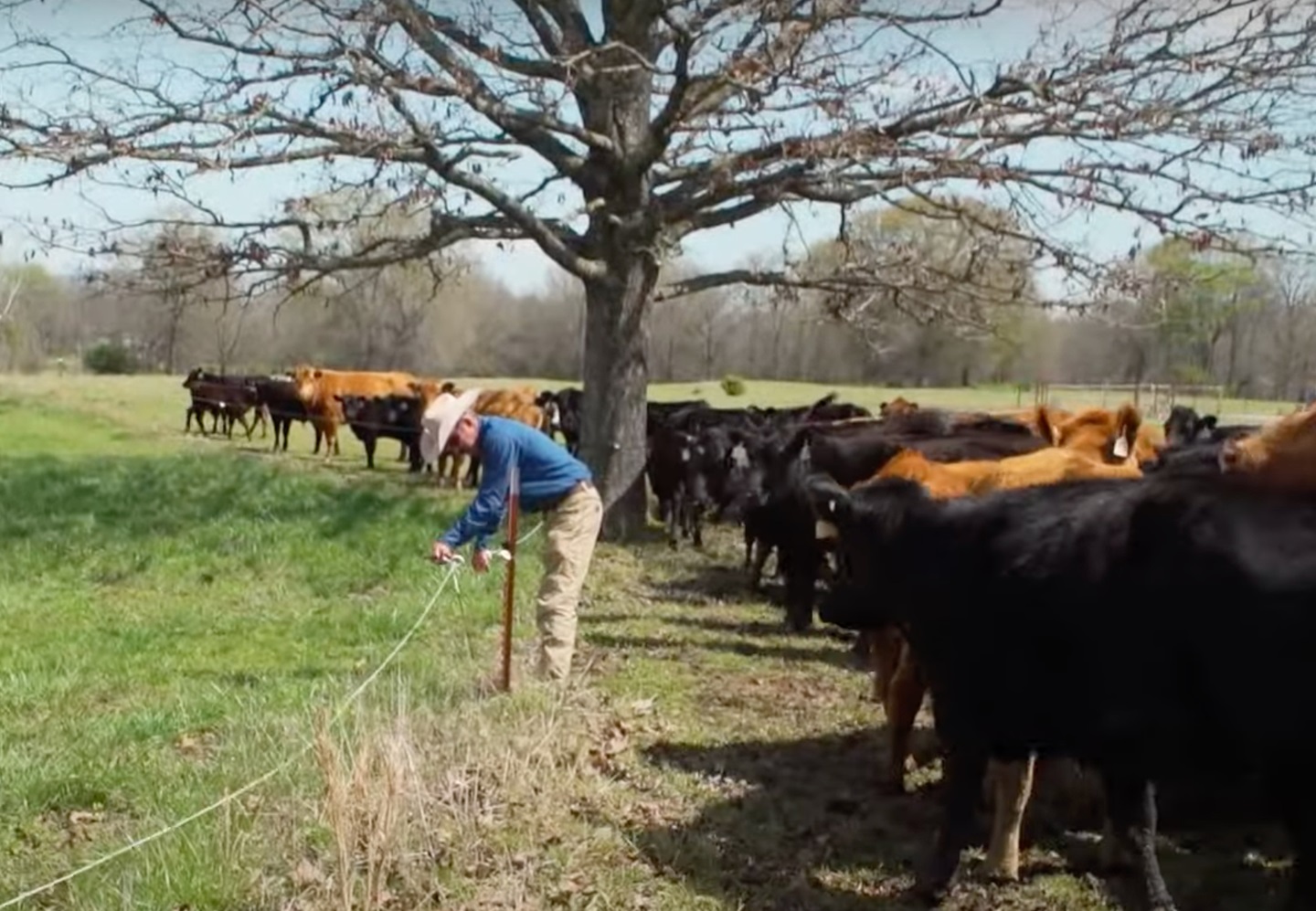Winning the BRD Battle: Stress Reduction and Smart Management
Using the right vaccines and being prompt when treating sick cattle saves lives.
May 21, 2025

John Hambrick and his veterinarian, Kevin Fenton, check cows near Rock Island, Okla.
by Boehringer Ingelheim
Limiting stress and maintaining a strong relationship with a veterinarian are vital for an Oklahoma rancher’s success in fighting bovine respiratory disease (BRD).
Several years ago, John Hambrick, owner of Rafter H Ranch near Rock Island, Okla., wanted to know how prevalent health issues like BRD and bovine viral diarrhea virus (BVDV) were in his cow herd, so he implemented a testing program. Based on the results, he could make culling decisions and management changes.
“We were able to get a baseline for the herd and then develop a vaccination program based on the recommendations of my veterinarian, Dr. Kevin Fenton, which enabled us to basically eliminate our disease sources in-house,” says Hambrick.
Determining whether disease is a problem in a cow herd or from any purchased cattle through testing is something Jody Wade, veterinarian for Boehringer Ingelheim, also recommends.
“You can buy some of your problems, so testing is something that you definitely need to plan for when you’re buying replacement heifers and bulls.”
— Jody Wade
“You can buy some of your problems, so testing is something that you definitely need to plan for when you’re buying replacement heifers and bulls,” asserts Wade. “Screen those cattle to ensure they’re not persistently infected with BVDV or any other type of virus that they can bring into your operation.”
Hambrick is a third-generation rancher in the wooded hills of eastern Oklahoma who raises commercial Angus cattle mixed with Simmental and Hereford genetics. The herd is divided into two-thirds fall calving and one-third spring calving.
“The cattle are happy here,” says Hambrick. “I think that we’ve matched our animals to the ecosystem they live in now.”
Routine vaccination
Building immunity gives cattle a strong first line of defense against BRD and other diseases.
“Immunity starts with healthy cows and creating an environment in utero where calves can thrive,” notes Wade. “After calves are born, we want to make sure they get quality colostrum so they can build antibodies against those diseases that they’re going to battle. Once calves get old enough, we can start a vaccination protocol with the right products at the right time, so that we can continue protecting calves through the next phase.”
Wade advises cattle producers to work with their veterinarian similarly to how the Rafter H Ranch and Fenton have collaborated on a vaccination protocol.
“The vaccines that I use to keep my cattle healthy have been recommended to me by Dr. Fenton,” says Hambrick. “He lives in my area, so he’s familiar with our challenges. If something new comes down the road that he likes and recommends it to me, I’m all for it. I trust him 100%.”
Hambrick and Fenton work together to coordinate vaccinations with his herd’s reproductive schedule.
“The vaccine I use, Pyramid®, is wonderful for addressing respiratory disease, and we just get such a good response out of it that there’s no reason for me to change,” says Hambrick. “I personally can see as much immunity coverage with a single dose of the modified-live vaccine we use as I was getting with two and three doses of the old killed vaccines.”
In addition to running cows, Hambrick occasionally buys preconditioned calves to run as stockers, depending on markets and forage availability. A recent set of stockers he bought received the same vaccine protocol as his own calves, and he was pleased with the results.
“They made it all the way through the grow yard and to the feedlot with zero death loss,” Hambrick says. “That protocol not only works on a farm with a known source of cattle, but also unknown sources of commingled calves.”
Just as important as having a vaccination protocol that works is having a veterinarian you can depend on to provide you with the necessary input.
“You’ve got to have a relationship with your vet,” says Hambrick. “You’ve got to have somebody at the other end of that phone who will answer when you call. Sure, we’ve been doing this for a long time, but things still come up.”
Stress reduction
“We manage for stress because, of course, naturally, you’re going to get it,” he adds.
One of the best ways to reduce stress is to minimize the number of times cattle need to be worked each year, by performing all necessary practices, when possible, at a few key times. Building calf immunity with a vaccine program can help reduce the need to pull sick animals for treatment.
Docile cattle are also key. Hambrick has made docility one of the key genetic parameters he looks for in bulls and when making replacement decisions.
“We’re not in a situation where we’re triggering a response to create BRD.”
— John Hambrick
“We’re not in a situation where we’re triggering a response to create BRD,” shares Hambrick. “We’re tickled with the way things are right now. [I’m] not saying I don’t ever ‘doctor.’ Sure we do. We’ve got 450 pairs.”
Hambrick’s calves may need treatment when they are young and still with cows, because of a stress challenge like weather. However, because of the low-stress environment, paired with a routine whole-herd vaccination program, calf health has improved overall.
“It’s not uncommon at weaning to never doctor a calf,” says Hambrick. “As far as a wreck, we’ve avoided the risks.”
Even the best management practices and vaccine protocols can’t prevent BRD entirely, so having a treatment plan is necessary. Wade recommends watching calves for any symptoms and treating them as soon as possible.
“If we can catch them early, we can get ahead of that disease,” says Wade. “As far as antibiotics are concerned, choosing an antibiotic that we know has a broad spectrum of coverage and gets into the lungs quickly to kill bacteria is important. It also needs to have a long duration, so that we don’t have to come back and re-treat.”
By emphasizing stress reduction and vaccinations, the Rafter H Ranch has been able to see a sizable effect. Calves wean off the mature cows averaging more than 600 pounds (lb.), while calves from first-calf heifers are just above 500 lb., and with few treatments across the herd.
“As we look forward to the next calf crop, going from here on out, our BRD plan will be to continue our vaccination protocol as we have now, combining that with minimal stress, adequate nutrition and the genetics we have in place,” concludes Hambrick.

John Hambrick moves cattle to a different pasture at Rafter H Ranch.
Editor’s note: This article is provided by Boehringer Ingelheim. [Lead photo courtesy Boehringer Ingelheim.]
Angus Beef Bulletin EXTRA, Vol. 17, No. 5-B
Topics: Health , Management
Publication: Angus Beef Bulletin


